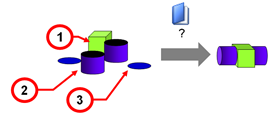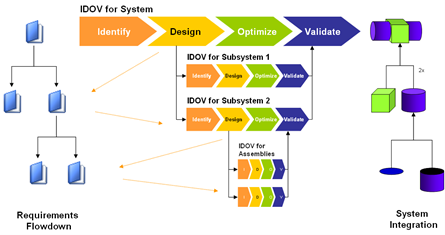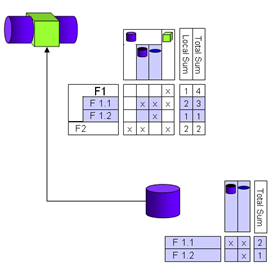Design Projects for products, processes or systems quickly gain complexity as the level of detail grows. On the other hand making design decisions requires this level of detail. Key success factors in coping with complexity are modularization and reuse. Qualica 19 provides tools to understand and represent modularity and enable reuse.
Subsystems
Subsystems provide support for a Systems Engineering approach to complexity. Functional requirements can be broken down to a certain level of detail and a conceptual design selected to meet those requirements. The next level of detail can then be described in a subsystem project.
Example: Complex System

System components include:
- Motor Unit
- Wheel
- Cap
Systems Engineering Approach: Requirements Flow Down

The System project is developed to a useful level of detail. Requirements are received from the higher-level system.Each subsystem has a separate project workbook.
Subsystems are Designed Seperately
Each sub project can be designed as a separate entity. Qualica Project Workbooks can be shared and worked on by different teams by adding them to a repository for access by other users.

Integration in Tables and Matrices
Qualica Project Workbooks link and display subsystem content within Domain Trees, Tables and Matrices.

You can move data under a pair of row and column items into a sub project. You can also import existing subprojects.
Shared Definitions
In some situations reuse of subsystem projects is not possible, but you may nevertheless need to resue certain elements from other projects. Basic specifications or test cases typically are standardized and used in many or all design projects of an organization.
| Example: Requirements on mechanical robustness and lifetime, such as drop testing, corrosion resistance etc. may be needed by many if not all projects. |
To re-use specifications or test cases you can mark any item in Domain Trees, Tables and Matrices as shared. Shared items can then be exported to a database of standard definitions. Standardized definitions can be loaded by new projects to ensure consistent use and terminology. Changes and updates in the database can be loaded by projects to update their local definitions.
Layers
Some products, processes or systems exist in different variants. You can add layers to tables and matrices to document differences between these variants.
TIP: Many template workbooks and worksheets already have predefined layers.
Layers are useful if the requirements, design elements or process steps of your system are largely identical but individual values differ. This is typically the case with processes designed to handle different products or cases. Other uses include product families with different specifications (e.g. a 20W, 35W, 50W lamp). Layers can be added to any matrix or table.
Design Structure Matrix
Unlike the three options listed above the Design Structure matrix is not a tool for mapping complexity, but for identifying structure.
DSM Partitioning
Partitioning will rearrange matrix rows and columns so all relations are moved to the lower triangular matrix as far as possible.
DSM (Design Structire Matrix) partitioning can be used to reorganize the matrix by bring items into an easy to understand sequence. In AD (Axiomatic Design) partitioning is referred to as decoupling of the matrix. Typically DSMs refer to cause effect matrices between elements from the same Domain Tree, while AD refers to matrices between different Domain Trees.
